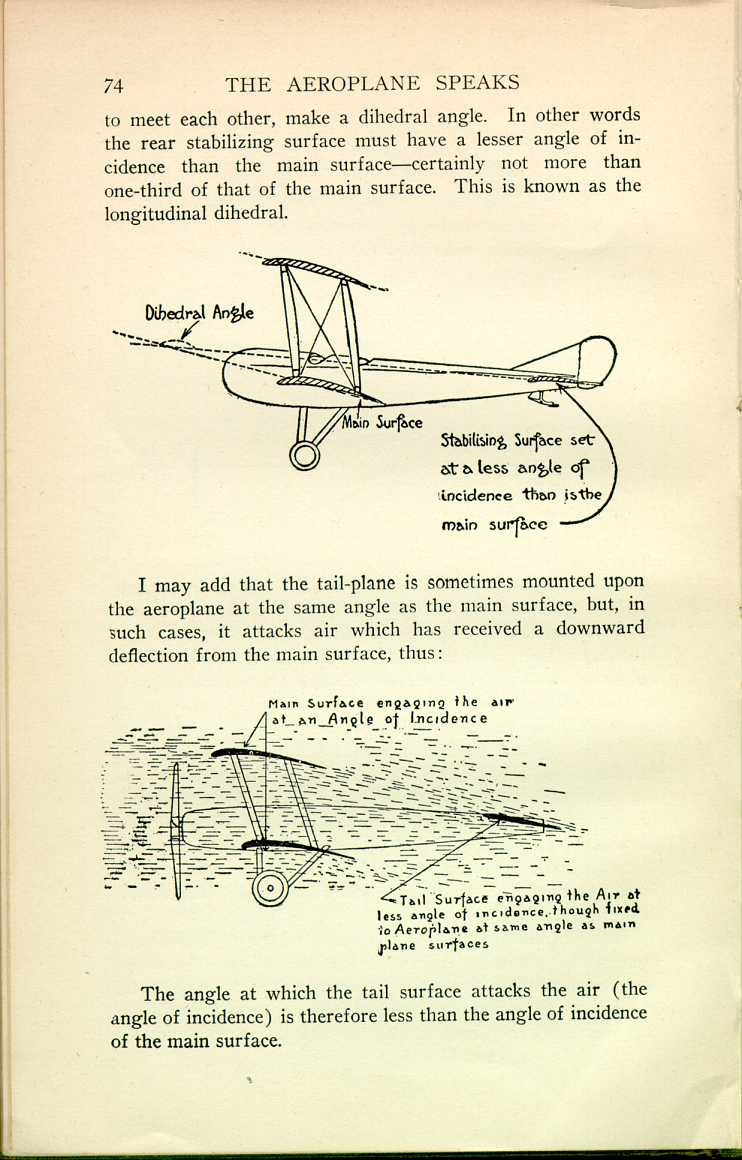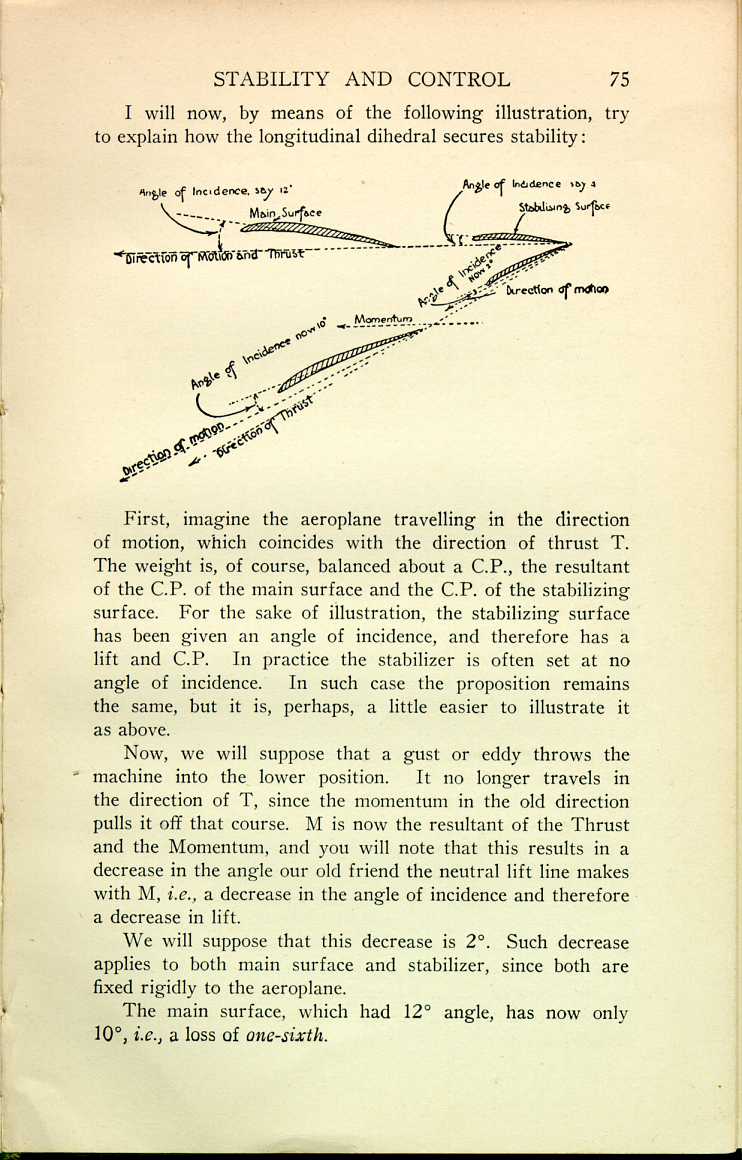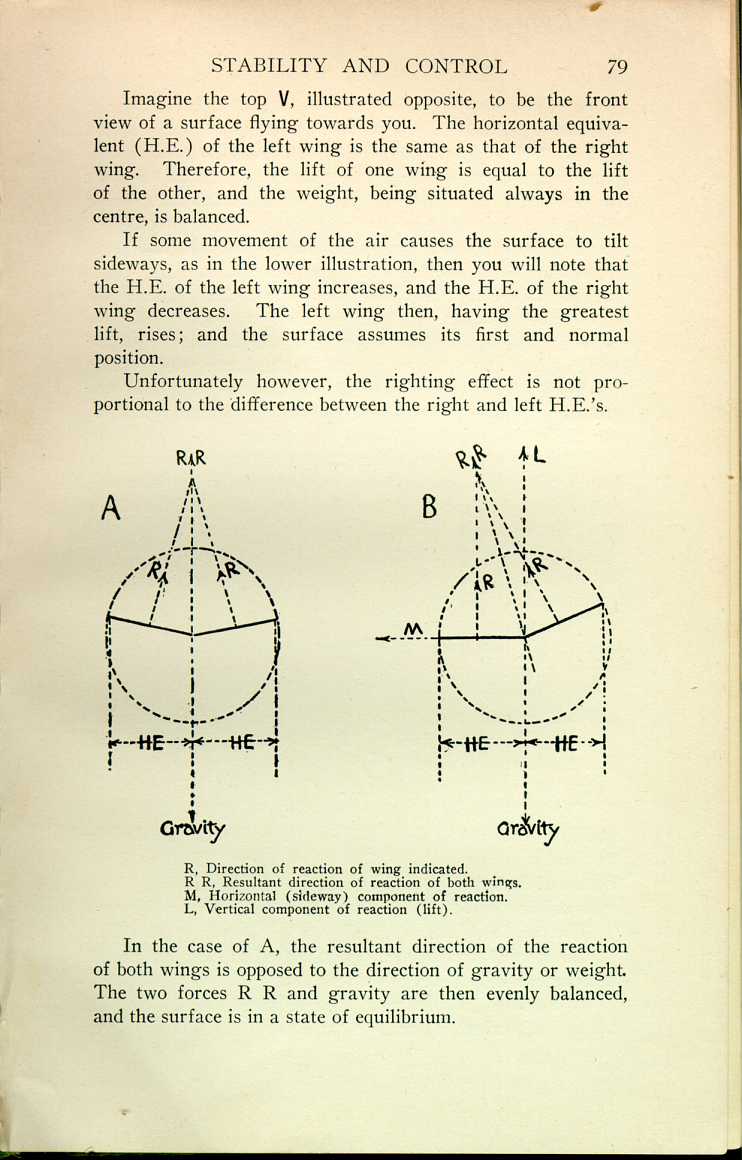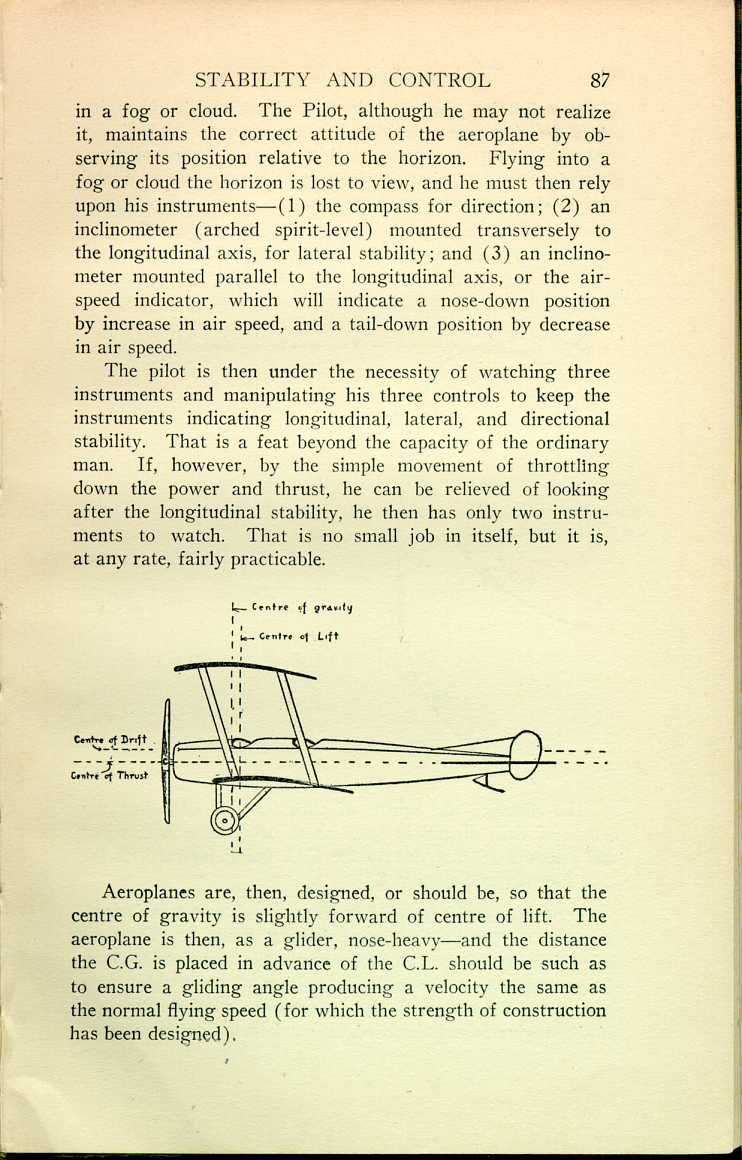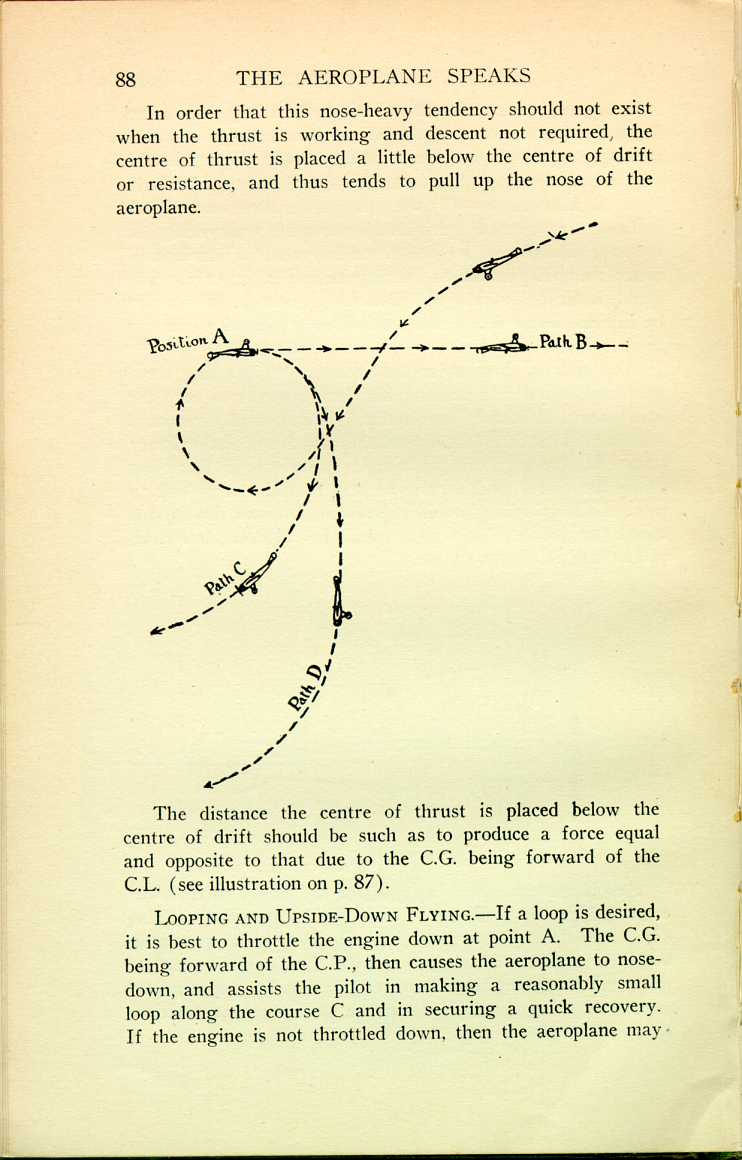|
CHAPTER II
STABILITY AND CONTROL
The Aeroplane Speaks | ||
2.
CHAPTER II
STABILITY AND CONTROL
Stability is a condition whereby an object disturbed has a natural tendency to return to its first and normal position. Example: a weight suspended by a cord.
Instability is a condition whereby an object disturbed has a natural tendency to move as far as possible away from its first position, with no tendency to return. Example: a stick balanced vertically upon your finger.
Neutral Instability is a condition whereby an object disturbed has no tendency to move farther than displaced by the force of the disturbance, and no tendency to return to its first position.
i order that an aeroplane may be reasonably controllable, it is necessary for it to possess some degree of stability longitudinally, laterally, and directionally.
Longitudinal Stability in an aeroplane is its stability about an axis transverse to the direction of normal horizontal flight, and without which it would pitch and toss.
Lateral Stability is its stability about its longitudinal axis, and without which it would roll sideways.
Directional Stability is its stability about its vertical axis, and without which it would have no tendency to keep its course.
For such directional stability to exist there must be, in effect,[1] more "keel-surface" behind the vertical axis than there is in front of it. By keel-surface I mean everything
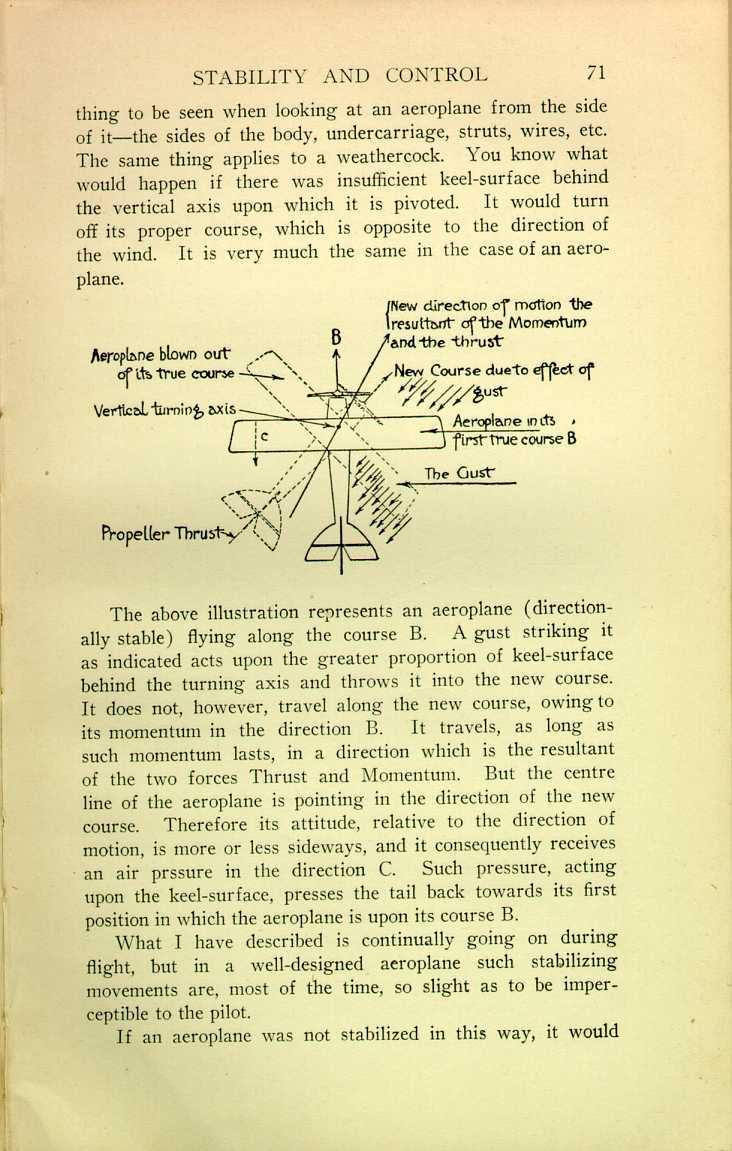 [Description:
Diagram showing a plane turning in response to a gust.
]
[Description:
Diagram showing a plane turning in response to a gust.
]
The above illustration represents an aeroplane (directionally stable) flying along the course B. A gust striking it as indicated acts upon the greater proportion of keel-surface behind the turning axis and throws it into the new course. It does not, however, travel along the new course, owing to its momentum in the direction B. It travels, as long as such momentum lasts, in a direction which is the resultant of the two forces Thrust and Momentum. But the centre line of the aeroplane is pointing in the direction of the new course. Therefore its attitude, relative to the direction of motion, is more or less sideways, and it consequently receives an air pressure in the direction C. Such pressure, acting upon the keel-surface, presses the tail back towards its first position in which the aeroplane is upon its course B.
What I have described is continually going on during flight, but in a well-designed aeroplane such stabilizing movements are, most of the time, so slight as to be imperceptible to the pilot.
If an aeroplane was not stabilized in this way, it would
Longitudinal Stability.—Flat surfaces are longitudinally stable owing to the fact that with decreasing angles of incidence the centre line of pressure (C.P.) moves forward.
The C.P. is a line taken across the surface, transverse to the direction of motion, and about which all the air forces may be said to balance, or through which they may be said to act.
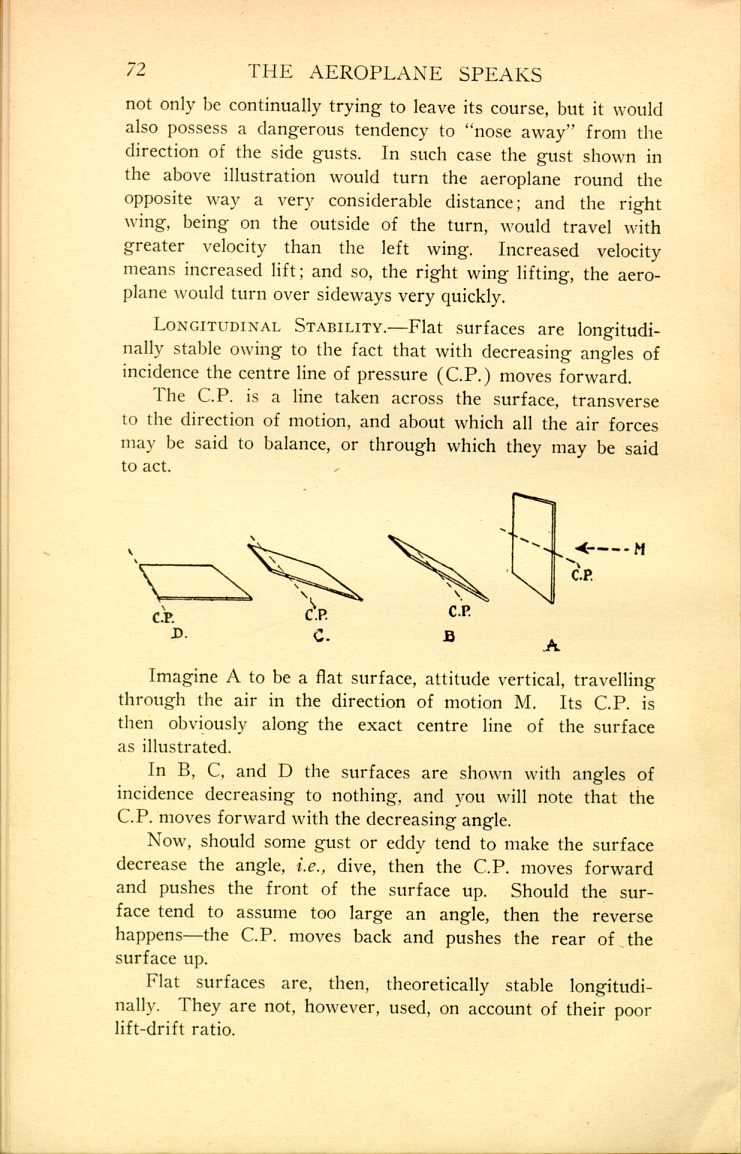 [Description:
Diagram showing four surfaces at varying angles of incidence.
]
[Description:
Diagram showing four surfaces at varying angles of incidence.
]
Imagine A to be a flat surface, attitude vertical, travelling through the air in the direction of motion M. Its C.P. is then obviously along the exact centre line of the surface as illustrated.
In B, C, and D the surfaces are shown with angles of incidence decreasing to nothing, and you will note that the C.P. moves forward with the decreasing angle.
Now, should some gust or eddy tend to make the surface decrease the angle, i.e., dive, then the C.P. moves forward and pushes the front of the surface up. Should the surface tend to assume too large an angle, then the reverse happens—the C.P. moves back and pushes the rear of the surface up.
Flat surfaces are, then, theoretically stable longitudinally. They are not, however, used, on account of their poor lift-drift ratio.
As already explained, cambered surfaces are used, and these are longitudinally unstable at those angles of incidence producing a reasonable lift-drift ratio, i.e., at angles below: about 12°.
A is a cambered surface, attitude approximately vertical, moving through the air in the direction M. Obviously the C. P. coincides with the transverse centre line of the surface.
With decreasing angles, down to angles of about 30°, the C.P. moves forward as in the case of flat surfaces (see B), but angles above 30° do not interest us, since they produce a very low ratio of lift to drift.
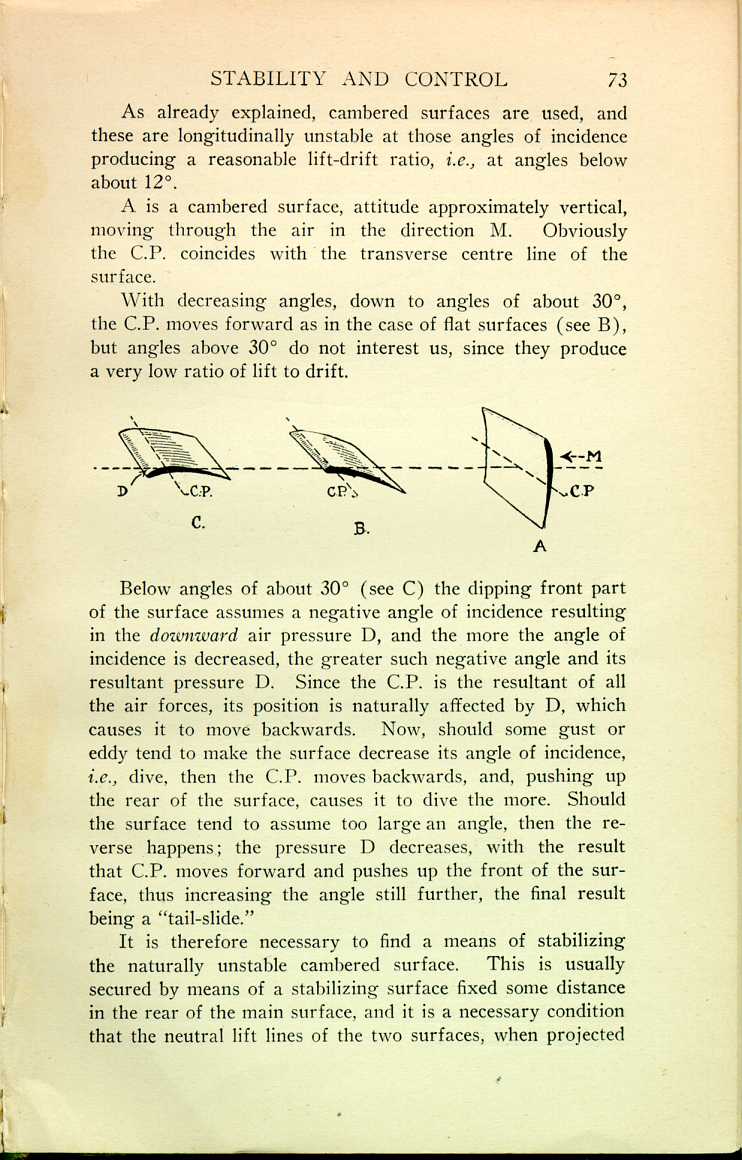 [Description:
Diagram showing three surfaces at varying angles of incidence.
]
[Description:
Diagram showing three surfaces at varying angles of incidence.
]
Below angles of about 30° (see C) the dipping front part of the surface assumes a negative angle of incidence resulting in the downward air pressure D, and the more the angle of incidence is decreased, the greater such negative angle and its resultant pressure D. Since the C.P. is the resultant of all the air forces, its position is naturally affected by D, which causes it to move backwards. Now, should some gust or eddy tend to make the surface decrease its angle of incidence, i.e., dive, then the C.P. moves backwards, and, pushing up the rear of the surface, causes it to dive the more. Should the surface tend to assume too large an angle, then the reverse happens; the pressure D decreases, with the result that C.P. moves forward and pushes up the front of the surface, thus increasing the angle still further, the final result being a "tail-slide."
It is therefore necessary to find a means of stabilizing the naturally unstable cambered surface. This is usually secured by means of a stabilizing surface fixed some distance in the rear of the main surface, and it is a necessary condition that the neutral lift lines of the two surfaces, when projected
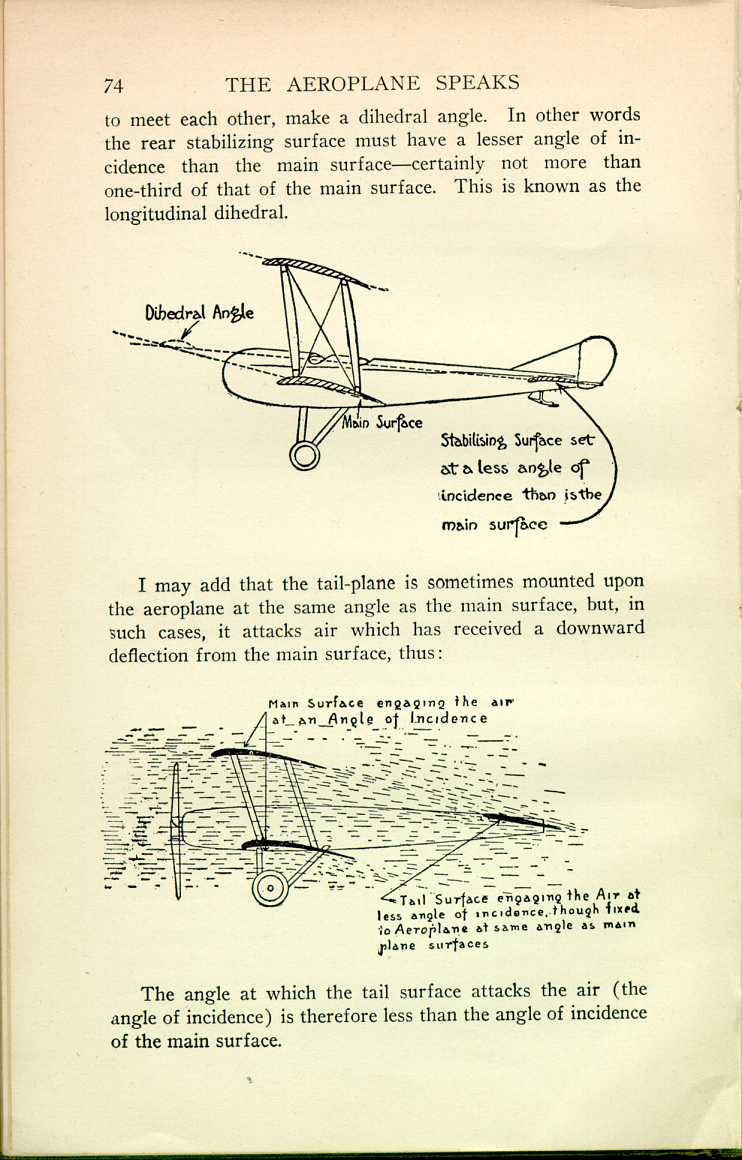 [Description:
Illustration of a plane with the dihedral angle labeled.
]
[Description:
Illustration of a plane with the dihedral angle labeled.
]
I may add that the tail-plane is sometimes mounted upon the aeroplane at the same angle as the main surface, but, in such cases, it attacks air which has received a downward deflection from the main surface, thus:
The angle at which the tail surface attacks the air (the angle of incidence) is therefore less than the angle of incidence of the main surface.
I will now, by means of the following illustration, try to explain how the longitudinal dihedral secures stability:
First, imagine the aeroplane travelling in the direction of motion, which coincides with the direction of thrust T. The weight is, of course, balanced about a C.P., the resultant of the C.P. of the main surface and the C.P. of the stabilizing surface. For the sake of illustration, the stabilizing surface has been given an angle of incidence, and therefore has a lift and C.P. In practice the stabilizer is often set at no angle of incidence. In such case the proposition remains the same, but it is, perhaps, a little easier to illustrate it as above.
Now, we will suppose that a gust or eddy throws the machine into the lower position. It no longer travels in the direction of T, since the momentum in the old direction pulls it off that course. M is now the resultant of the Thrust and the Momentum, and you will note that this results in a decrease in the angle our old friend the neutral lift line makes with M, i.e., a decrease in the angle of incidence and therefore a decrease in lift.
We will suppose that this decrease is 2°. Such decrease applies to both main surface and stabilizer, since both are fixed rigidly to the aeroplane.
The main surface, which had 12° angle, has now only 10°, i.e., a loss of one-sixth.
The stabilizer, which had 4° angle, has now only 2°, i.e., a loss of one-half.
The latter has therefore lost a greater proportionof its angle of incidence, and consequently its lift, than has the main surface. It must then fall relative to the main surface. The tail falling, the aeroplane then assumes its first position, though at a slightly less altitude.
Should a gust throw the nose of the aeroplane up, then the reverse happens. Both main surface and stabilizer increase their angles of incidence in the same amount, but the angle, and therefore the lift, of the stabilizer increases in greater proportion than does the lift of the main surface, with the result that it lifts the tail. The aeroplane then assumes its first position, though at a slightly greater altitude.
Do not fall into the widespread error that the angle of incidence varies as the angle of the aeroplane to the horizontal. It varies with such angle, but not as anything approaching it. Remember that the stabilizing effect of the longitudinal dihedral lasts only as long as there is momentum in the direction of the first course.
These stabilizing movements are taking place all the time, even though imperceptible to the pilot.
Aeroplanes have, in the past, been built with a stabilizing surface in front of the main surface instead of at the rear of it. In such design the main surface (which is then the tail surface as well as the principal lifting surface) must be set at a less angle than the forward stabilizing surface, in order to secure a longitudinal dihedral. The defect of such design lies in the fact that the main surface must have a certain angle to lift the weight—say 5°. Then, in order to secure a sufficiency of longitudinal stability, it is necessary to set the forward stabilizer at about 15°. Such a large angle of incidence results in a very poor lift-drift ratio (and consequently great loss of efficiency), except at very low velocities compared with the speed of modern aeroplanes. At the time such aeroplanes were built velocities were comparatively low, and this defect was; for that reason, not sufficiently appreciated. In the end it killed the "canard" or "tail-first" design.
Aeroplanes of the Dunne and similar types possess no stabilizing surface distinct from the main surface, but they have a longitudinal dihedral which renders them stable.
The main surface towards the wing-tips is given a decreasing angle of incidence and corresponding camber. The wing-tips then act as longitudinal stabilizers.
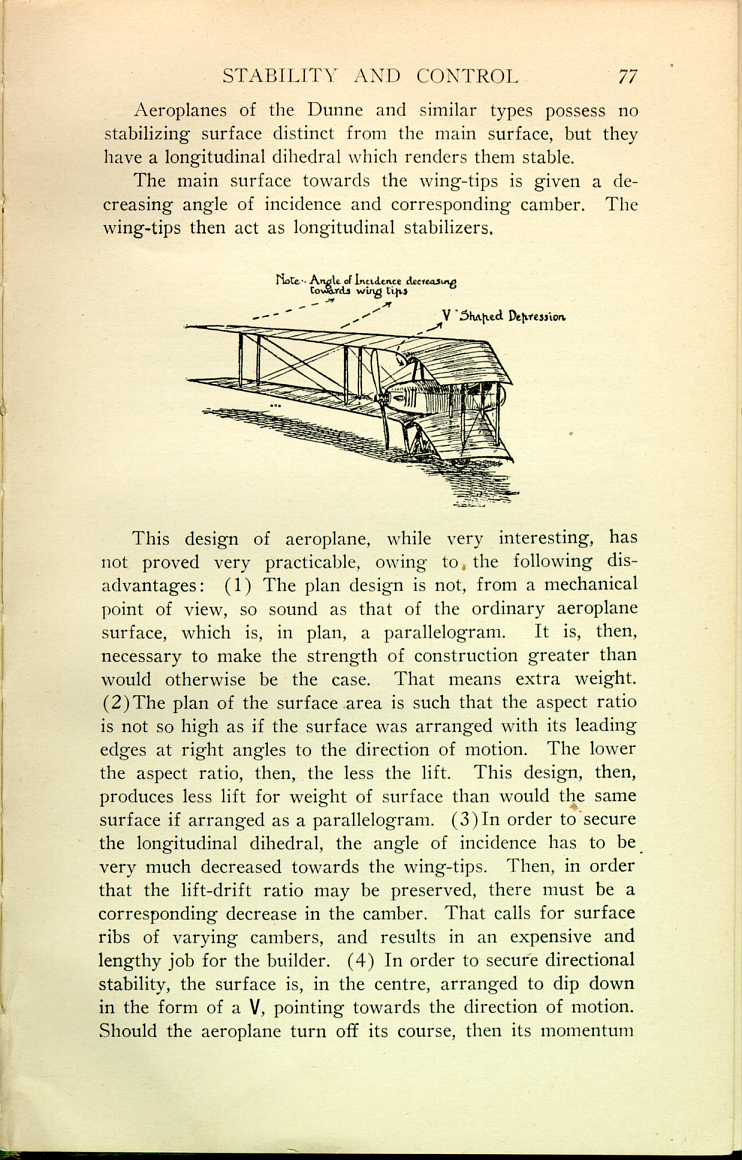 [Description:
Illustration showing the angle created by the wings.
]
[Description:
Illustration showing the angle created by the wings.
]
This design of aeroplane, while very interesting, has not proved very practicable, owing to the following disadvantages: (1) The plan design is not, from a mechanical point of view, so sound as that of the ordinary aeroplane surface, which is, in plan, a parallelogram. It is, then, necessary to make the strength of construction greater than would otherwise be the case. That means extra weight. (2) The plan of the surface area is such that the aspect ratio is not so high as if the surface was arranged with its leading edges at right angles to the direction of motion. The lower the aspect ratio, then, the less the lift. This design, then, produces less lift for weight of surface than would the same surface if arranged as a parallelogram. (3) In order to secure the longitudinal dihedral, the angle of incidence has to be very much decreased towards the wing-tips. Then, in order that the lift-drift ratio may be preserved, there must be a corresponding decrease in the camber. That calls for surface ribs of varying cambers, and results in an expensive and lengthy job for the builder. (4) In order to secure directional stability, the surface is, in the centre, arranged to dip down in the form of a V, pointing towards the direction of motion. Should the aeroplane turn off its course, then its momentum
The gyroscopic action of a rotary engine will affect the longitudinal stability when an aeroplane is turned to right or left. In the case of a Gnome engine, such gyroscopic action will tend to depress the nose of the aeroplane when it is turned to the left, and to elevate it when it is turned to the right. In modern aeroplanes this tendency is not sufficiently important to bother about. In the old days of crudely designed and under-powered aeroplanes this gyroscopic action was very marked, and led the majority of pilots to dislike turning an aeroplane to the right, since, in doing so, there was some danger of "stalling."
Lateral Stability is far more difficult for the designer to secure than is longitudinal or directional stability. Some degree of lateral stability may be secured by means of the "lateral dihedral," i.e., the upward inclination of the surface towards its wing-tips thus:
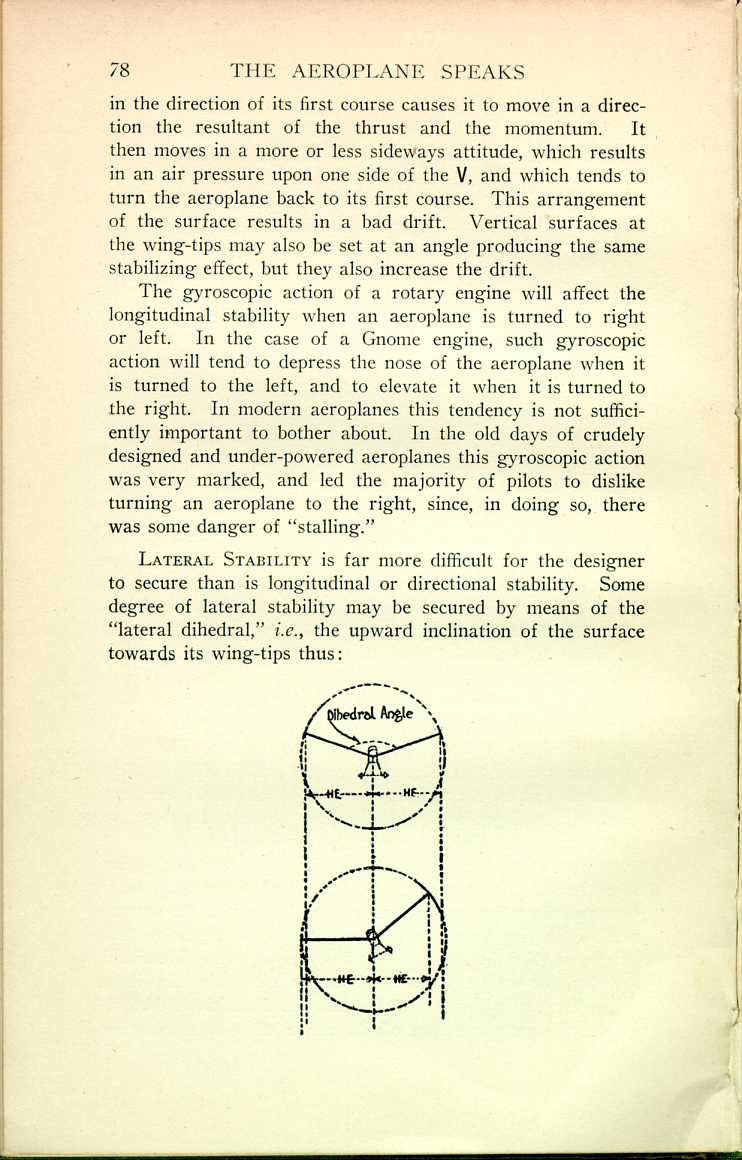 [Description:
Diagram showing the effect of different wing positions.
]
[Description:
Diagram showing the effect of different wing positions.
]
Imagine the top V, illustrated opposite, to be the front view of a surface flying towards you. The horizontal equivalent (H.E.) of the left wing is the same as that of the right wing. Therefore, the lift of one wing is equal to the lift of the other, and the weight, being situated always in the centre, is balanced.
If some movement of the air causes the surface to tilt sideways, as in the lower illustration, then you will note that the H.E. of the left wing increases, and the H.E. of the right wing decreases. The left wing then, having the greatest lift, rises; and the surface assumes its first and normal position.
Unfortunately however, the righting effect is not proportional to the difference between the right and left H.E.'s.
In the case of A, the resultant direction of the reaction of both wings is opposed to the direction of gravity or weight. The two forces R R and gravity are then evenly balanced, and the surface is in a state of equilibrium.
In the case of B, you will note that the R R is not directly opposed to gravity. This results in the appearance of M, and so the resultant direction of motion of the aeroplane is no longer directly forward, but is along a line the resultant of the thrust and M. In other words, it is, while flying forward, at the same time moving sideways in the direction M.
In moving sideways, the keel-surface receives, of course, a pressure from the air equal and opposite to M. Since such surface is greatest in effect towards the tail, then the latter must be pushed sideways. That causes the aeroplane to turn; and, the highest wing being on the outside of the turn, it has a greater velocity than the lower wing. That produces greater lift, and tends to tilt the aeroplane over still more. Such tilting tendency is, however, opposed by the difference in the H.E.'s of the two wings.
It then follows that, for the lateral dihedral angle to be effective, such angle must be large enough to produce, when the aeroplane tilts, a difference in the H.E.'s of the two wings, which difference must be sufficient to not only oppose the tilting tendency due to the aeroplane turning, but sufficient to also force the aeroplane back to its original position of equilibrium.
It is now, I hope, clear to the reader that the lateral dihedral is not quite so effective as would appear at first sight. Some designers, indeed, prefer not to use it, since its effect is not very great, and since it must be paid for in loss of H.E. and consequently loss of lift, thus decreasing the lift-drift ratio, i.e., the efficiency. Also, it is sometimes advanced that the lateral dihedral increases the "spill" of air from the wing-tips and that this adversely affects the lift-drift ratio.
The disposition of the keel-surface affects the lateral stability. It should be, in effect, equally divided by the longitudinal turning axis of the aeroplane. If there is an excess of keel-surface above or below such axis, then a side gust striking it will tend to turn the aeroplane over sideways.
The position of the centre of gravity affects lateral stability. If too low, it produces a pendulum effect and causes the aeroplane to roll sideways.
If too high, it acts as a stick balanced vertically would act. If disturbed, it tends to travel to a position as far as
From the point of view of lateral stability, the best position for the centre of gravity is one a little below the centre of drift.
Propeller torque affects lateral stability. An aeroplane tends to turn over sideways in the opposite direction to which the propeller revolves.
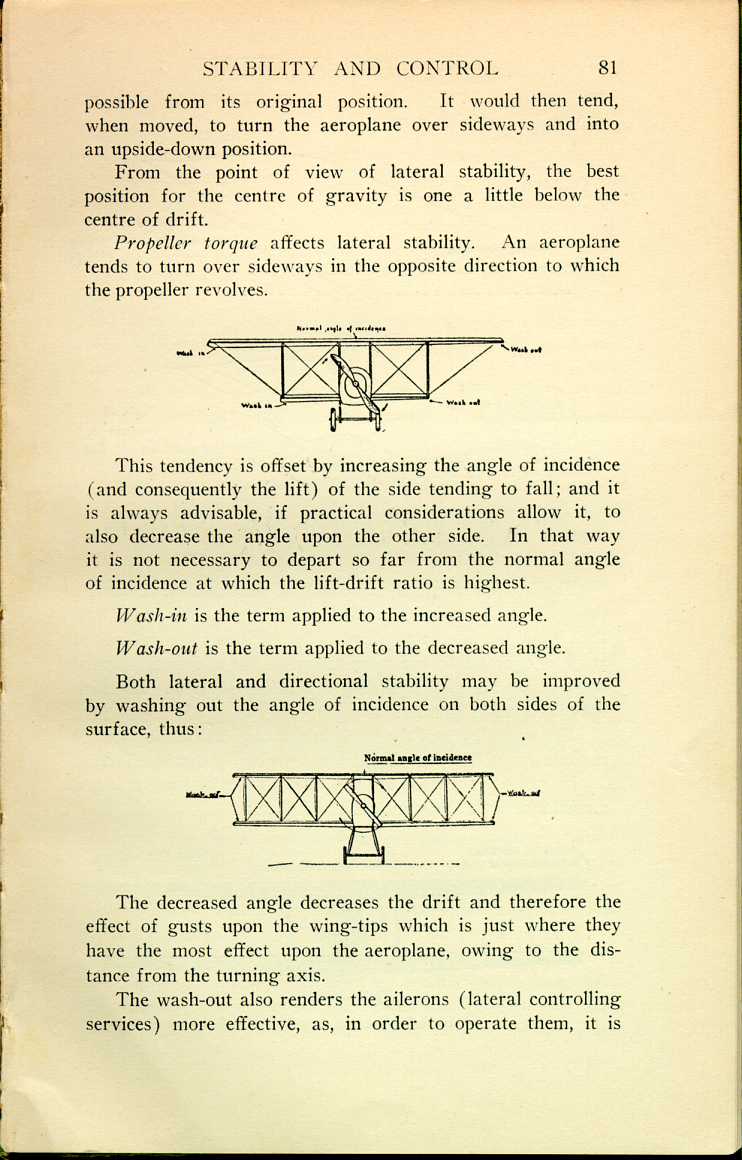 [Description:
Front view illustration of a plane, demonstrating wash in and wash out.
]
[Description:
Front view illustration of a plane, demonstrating wash in and wash out.
]
This tendency is offset by increasing the angle of incidence (and consequently the lift) of the side tending to fall; and it is always advisable, if practical considerations allow it, to also decrease the angle upon the other side. In that way it is not necessary to depart so far from the normal angle of incidence at which the lift-drift ratio is highest.
Wash-in is the term applied to the increased angle.
Wash-out is the term applied to the decreased angle.
Both lateral and directional stability may be improved by washing out the angle of incidence on both sides of the surface, thus:
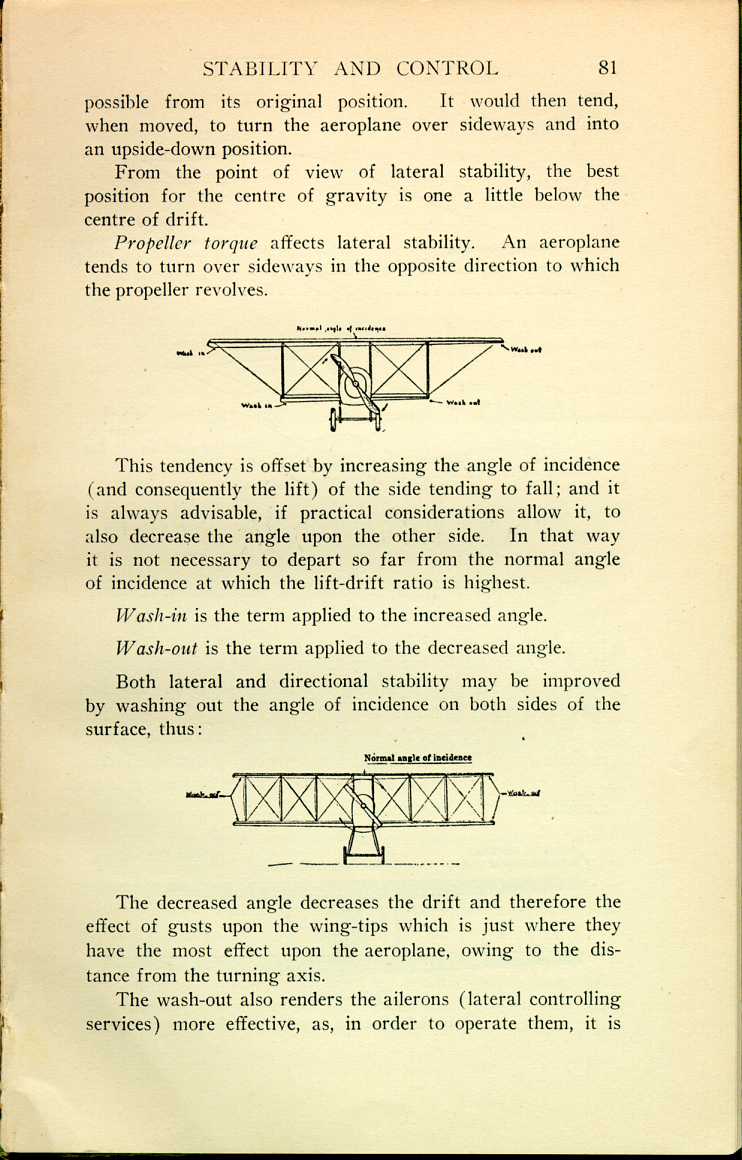 [Description:
Front view illustration of a plane, demonstrating wash in and wash out.
]
[Description:
Front view illustration of a plane, demonstrating wash in and wash out.
]
The decreased angle decreases the drift and therefore the effect of gusts upon the wing-tips which is just where they have the most effect upon the aeroplane, owing to the distance from the turning axis.
The wash-out also renders the ailerons (lateral controlling services) more effective, as, in order to operate them, it is
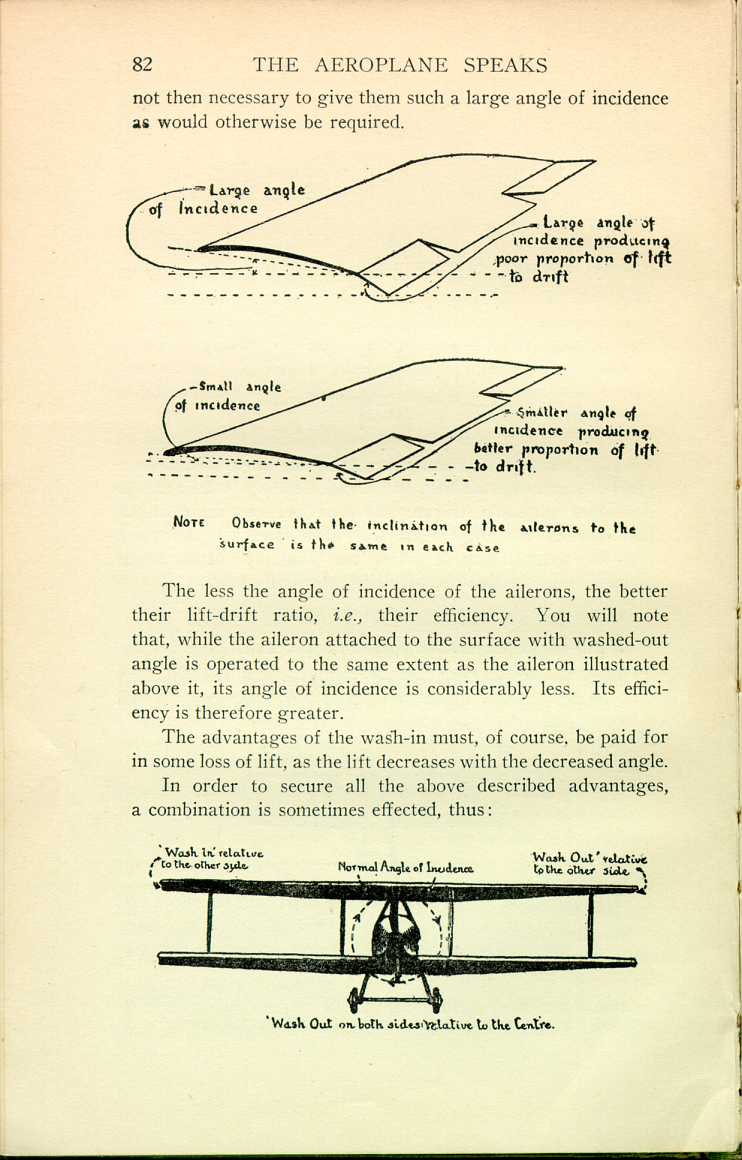 [Description:
Diagram showing how angle of incidence affects lift-drift ratio.
]
[Description:
Diagram showing how angle of incidence affects lift-drift ratio.
]
The less the angle of incidence of the ailerons, the better their lift-drift ratio, i.e., their efficiency. You will note that, while the aileron attached to the surface with washed-out angle is operated to the same extent as the aileron illustrated above it, its angle of incidence is considerably less. Its efficiency is therefore greater.
The advantages of the wash-in must, of course be paid for in some loss of lift, as the lift decreases with the decreased angle.
In order to secure all the above described advantages, a combination is sometimes effected, thus:
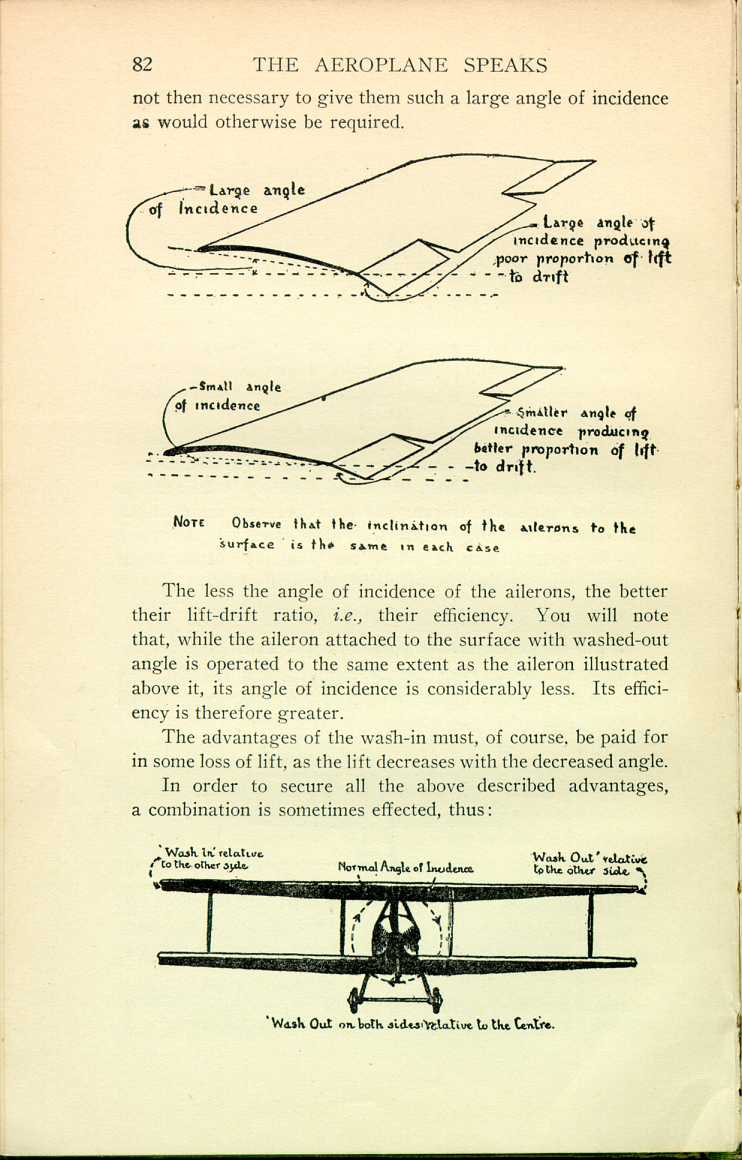 [Description:
Front view illustration of a plane, indicating wash in and wash out.
]
[Description:
Front view illustration of a plane, indicating wash in and wash out.
]
Banking.—An aeroplane turned off its course to right or left does not at once proceed along its new course. Its momentum in the direction of its first course causes it to travel along a line the resultant of such momentum and the thrust. In other words, it more or less skids sideways and away from the centre of the turn. Its lifting surfaces do not then meet the air in their correct attitude, and the lift may fall to such an extent as to become less than the weight, in which case the aeroplane must fall. This bad effect is minimized by "banking," i.e., tilting the aeroplane sideways. The bottom of the lifting surface is in that way opposed to the air through which it is moving in the direction of the momentum and receives an opposite air pressure. The rarefied area over the top of the surface is rendered still more rare, and this, of course, assists the air pressure in opposing the momentum.
The velocity of the "skid," or sideways movement, is then only such as is necessary to secure an air pressure equal and opposite to the centrifugal force of the turn.
The sharper the turn, the greater the effect of the centrifugal force, and therefore the steeper should be the "bank." Experentia docet.
The position of the centre of gravity affects banking. A low C.G. will tend to swing outward from the centre of the turn, and will cause the aeroplane to bank—perhaps too much, in which case the pilot must remedy matters by operating the ailerons.
A high C.G. also tends to swing outward from the centre of the turn. It will tend to make the aeroplane bank the wrong way, and such effect must be remedied by means of the ailerons.
The pleasantest machine from a banking point of view is one in which the C.G. is a little below the centre of drift. It tends to bank the aeroplane the right way for the turn, and the pilot can, if necessary, perfect the bank by means of the ailerons.
The disposition of the keel-surface affects banking. It should be, in effect, evenly divided by the longitudinal axis. An excess of keel-surface above the longitudinal axis will, when banking, receive an air pressure causing the aeroplane
Side-Slipping.—This usually occurs as a result of over-banking. It is always the result of the aeroplane tilting sideways and thus decreasing the horizontal equivalent, and therefore the lift, of the surface. An excessive "bank," or sideways tilt, results in the H.E., and therefore the lift, becoming less than the weight, when, of course, the aeroplane must fall, i.e., side-slip.
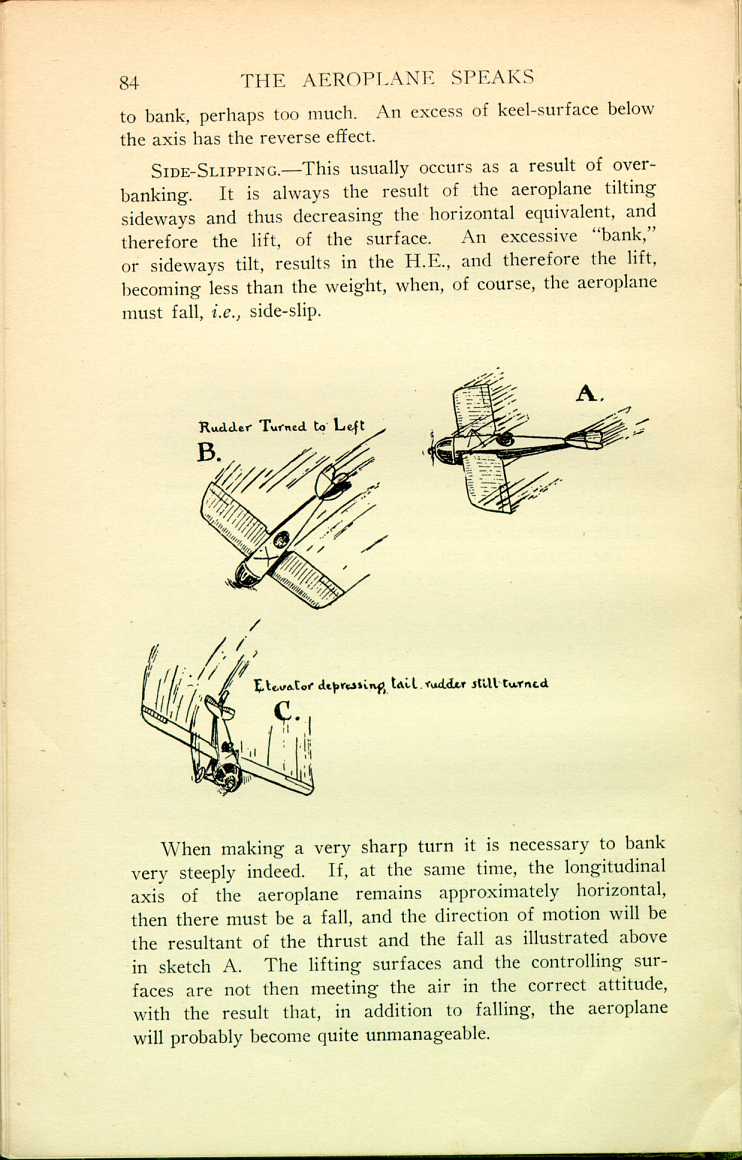 [Description:
Illustration showing a plane in the stages of a sharp turn.
]
[Description:
Illustration showing a plane in the stages of a sharp turn.
]
When making a very sharp turn it is necessary to bank very steeply indeed. If, at the same time, the longitudinal axis of the aeroplane remains approximately horizontal, then there must be a fall, and the direction of motion will be the resultant of the thrust and the fall as illustrated above in sketch A. The lifting surfaces and the controlling surfaces are not then meeting the air in the correct attitude, with the result that, in addition to falling, the aeroplane will probably become quite unmanageable.
The Pilot, however, prevents such a state of affairs from happening by "nosing-down," i.e., by operating the rudder to turn the nose of the aeroplane downward and towards the direction of motion as illustrated in sketch B. This results in the higher wing, which is on the outside of the turn, travelling with greater velocity, and therefore securing a greater reaction than the lower wing, thus tending to tilt the aeroplane over still more. The aeroplane is now almost upside-down, but its attitude relative to the direction of motion is correct and the controlling surfaces are all of them working efficiently. The recovery of a normal attitude relative to the Earth is then made as illustrated in sketch C.
The Pilot must then learn to know just the angle of bank at which the margin of lift is lost, and, if a sharp turn necessitates banking beyond that angle, he must "nose-down."
In this matter of banking and nosing-down, and, indeed, regarding stability and control generally, the golden rule for all but very experienced pilots should be: Keep the aeroplane in such an attitude that the air pressure is always directly in the pilot's face. The aeroplane is then always engaging the air as designed to do so, and both lifting and controlling surfaces are acting efficiently. The only exception to this rule is a vertical dive, and I think that is obviously not an attitude for any but very experienced pilots to hanker after.
Spinning.—This is the worst of all predicaments the pilot can find himself in. Fortunately it rarely happens.
It is due to the combination of (1) a very steep spiral descent of small radius, and (2) insufficiency of keel-surface behind the vertical axis, or the jamming of the rudder end or elevator into a position by which the aeroplane is forced into an increasingly steep and small spiral.
Owing to the small radius of such a spiral, the mass of the aeroplane may gain a rotary momentum greater, in effect, than the air pressure of the keel-surface or controlling surfaces opposed to it; and, when once such a condition occurs, it is difficult to see what can be done by the pilot to remedy it. The sensible pilot will not go beyond reasonable limits of steepness and radius when executing spiral descents.
Gliding Descent without Propeller Thrust.—All
aeroplanes are, or should be, designed to assume their gliding
angle when the power and thrust is cut off. This relieves
the pilot of work, worry, and danger should he find himself
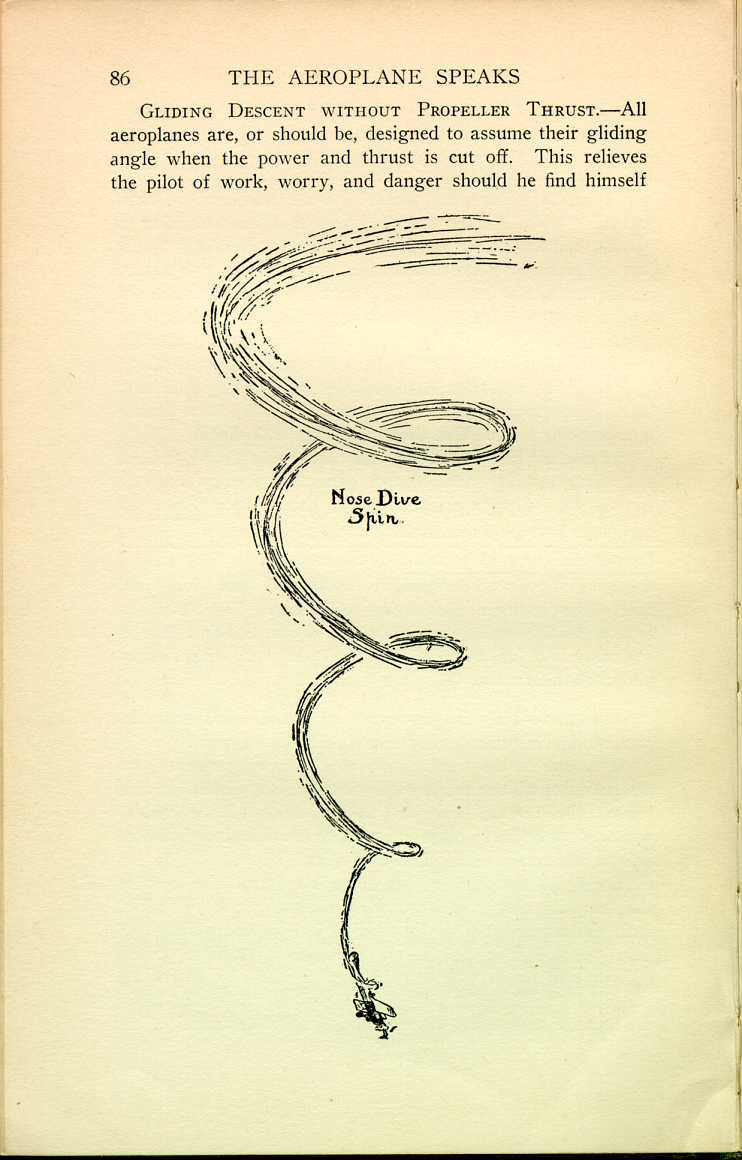 [Description:
Illustration of a plane in a nose dive spin.
]
[Description:
Illustration of a plane in a nose dive spin.
]
The pilot is then under the necessity of watching three instruments and manipulating his three controls to keep the instruments indicating longitudinal, lateral, and directional stability. That is a feat beyond the capacity of the ordinary man. If, however, by the simple movement of throttling down the power and thrust, he can be relieved of looking after the longitudinal stability, he then has only two instruments to watch. That is no small job in itself, but it is, at any rate, fairly practicable.
Aeroplanes are, then, designed, or should be, so that the centre of gravity is slightly forward of centre of lift. The aeroplane is then, as a glider, nose-heavy—and the distance the C.G. is placed in advance of the C.L. should be such as to ensure a gliding angle producing a velocity the same as the normal flying speed (for which the strength of construction has been designed).
In order that this nose-heavy tendency should not exist when the thrust is working and descent not required, the centre of thrust is placed a little below the centre of drift or resistance, and thus tends to pull up the nose of the aeroplane.
The distance the centre of thrust is placed below the centre of drift should be such as to produce a force equal and opposite to that due to the C.G. being forward of the C.L. (see illustration on p. 87).
Looping and Upside-Down Flying.—If a loop is desired, it is best to throttle the engine down at point A. The C.G. being forward of the C.P., then causes the aeroplane to nose-down, and assists the pilot in making a reasonably small loop along the course C and in securing a quick recovery. If the engine is not throttled down, then the aeroplane may
A steady, gentle movement of the elevator is necessary. A jerky movement may change the direction of motion so suddenly as to produce dangerous air stresses upon the surfaces, in which case there is a possibility of collapse.
If an upside-down flight is desired, the engine may, or may not, be throttled down at point A. If not throttled down, then the elevator must be operated to secure a course approximately in the direction B. If it is throttled down, then the course must be one of a steeper angle than B, or there will be danger of stalling.
"In effect" because, although there may be actually the greatest proportion of keel-surface In front of the vertical axis, such surface may be much nearer to the axis than is the keel-surface towards the tail. The latter may then be actually less than the surface in front, but, being farther from the axis, it has a greater leverage, and consequently is greater in effect than the surface in front.
|
CHAPTER II
STABILITY AND CONTROL
The Aeroplane Speaks | ||
